Do you have a question about the Abbott FreeStyle Navigator and is the answer not in the manual?
Overview of the user guide and system.
Details of the system kit and sensor kit contents.
Highlights key functionalities of the FreeStyle Navigator system.
Guidelines for daily activities and travel with the system.
Step-by-step instructions for initial system preparation.
Crucial cautions and important reminders for system use and calibration.
Preliminary information and considerations before system operation.
Explanation of the condition and its symptoms.
Description of Continuous Monitoring and Blood Glucose modes.
Objective and required items for battery replacement.
Procedure for installing or replacing the transmitter battery.
Procedure for installing or replacing the receiver batteries.
Steps to re-establish communication after battery changes.
Objective and conditions for setting system time and date.
Step-by-step guide to adjust the system's current time.
Step-by-step guide to adjust the system's current date.
Objective and triggers for performing a control solution test.
List of necessary items for the control solution test.
Steps to ensure control solution and test strips are current and ready.
Instructions for inserting test strip, comparing codes, applying solution, and interpreting results.
Steps to confirm the control solution test was performed correctly.
Objective and conditions for sensor insertion or removal.
Necessary items and key considerations before sensor insertion.
Options to change/remove sensor or insert a new one.
Detailed steps for safely removing the sensor and cleaning the transmitter.
Steps for preparing the site, inserting the sensor, and attaching the transmitter.
Procedure to verify the sensor is correctly inserted and adhered.
Guidelines for safely disposing of the sensor inserter.
Objective and timing for attaching the transmitter.
Tips for maintaining transmitter-receiver connection.
Steps to securely attach the transmitter to the sensor support mount.
Procedure for entering the sensor code into the receiver.
Objective and triggers for system calibration.
Required materials and important reminders for system calibration.
Detailed steps for inserting test strips and comparing code numbers.
Guidelines for choosing appropriate sites for blood glucose testing.
Steps for preparing the site, lancing, and collecting a blood sample.
Procedure for applying the sample and understanding the glucose readings.
Steps to confirm test type and properly discard used items.
Objective and timing for configuring alarm settings.
Explanation of high, low, and projected glucose alarms.
Steps to access and modify various alarm settings.
Procedure for configuring low glucose alarm settings.
Procedure for configuring high glucose alarm settings.
Steps to set projected low and high glucose alarms.
Configuration for data loss and system-related alarms.
Options for progress tones and muting audible alarms.
Objective and timing for daily system interaction.
Guidance on maintaining connection and periodic checks.
Steps to restore connection if lost.
Understanding the information displayed on the Continuous Monitoring screen.
Explanation of various icons and their meanings on the receiver.
Instructions for turning on the receiver's backlight.
Objective for resolving system alerts and issues.
Guidance on alarm response and urgency levels.
How to access and interpret system status details.
Detailed guide for addressing various alarm messages.
Solutions for common issues with the receiver, sensor, and connection.
Objective and timing for recording events.
Important notes on event entry and editing.
How to choose the type of event to record.
Procedures for logging meals, insulin, exercise, and health status.
How to record custom events.
Confirmation of accurate event record keeping.
Objectives for reviewing glucose data and events.
Guidance on glucose targets and their relation to alarms.
Steps to navigate to the reports menu.
Procedure to input desired glucose level targets.
How to display glucose levels over time using line graphs.
How to access statistical reports of glucose levels.
Steps to review and modify recorded events.
Objective and frequency for system cleaning.
Necessary cleaning supplies and important maintenance notes.
Instructions for cleaning the transmitter, receiver skin, and receiver.
Objective and conditions for linking/unlinking devices.
Key points regarding device pairing and communication.
Steps to remove the transmitter ID from the receiver.
Steps to pair the receiver with a transmitter.
Confirmation of successful linking or unlinking.
Objective to restore system settings to factory defaults.
Important notes regarding resetting settings and their impact.
Steps to access and perform the user settings reset.
Objective to adjust display formats and language.
Important notes on changing settings.
Steps to navigate to the country settings.
Procedures for changing language, date, time, and decimal formats.
Importance of site selection, preparation, and maintenance.
Recommendations for choosing and rotating sensor insertion sites.
List of products that can assist with site maintenance and adhesion.
Technical specifications for the system's operation and components.
Detailed specifications for the receiver unit.
Detailed specifications for the transmitter unit.
Overview of the system's performance in clinical studies.
Evaluation of system accuracy using error grid analysis and statistical data.
Data on system performance during the sensor wear period.
Information on sensor accuracy and stability over time.
Explanation of how glucose is measured in interstitial fluid.
Data on sensor precision and reproducibility.
Findings from a home-use study on sensor insertion and calibration.
Observed incidence of skin issues related to sensor use.
Guidance on potential sources and effects of electromagnetic interference.
Declarations regarding electromagnetic emissions compliance.
Declarations regarding electromagnetic immunity compliance.
FCC compliance details for the transmitter.
FCC compliance details for the receiver.
Definitions of terms used in the manual.
Alphabetical listing of topics and their corresponding page numbers.
Overview of the user guide and system.
Details of the system kit and sensor kit contents.
Highlights key functionalities of the FreeStyle Navigator system.
Guidelines for daily activities and travel with the system.
Step-by-step instructions for initial system preparation.
Crucial cautions and important reminders for system use and calibration.
Preliminary information and considerations before system operation.
Explanation of the condition and its symptoms.
Description of Continuous Monitoring and Blood Glucose modes.
Objective and required items for battery replacement.
Procedure for installing or replacing the transmitter battery.
Procedure for installing or replacing the receiver batteries.
Steps to re-establish communication after battery changes.
Objective and conditions for setting system time and date.
Step-by-step guide to adjust the system's current time.
Step-by-step guide to adjust the system's current date.
Objective and triggers for performing a control solution test.
List of necessary items for the control solution test.
Steps to ensure control solution and test strips are current and ready.
Instructions for inserting test strip, comparing codes, applying solution, and interpreting results.
Steps to confirm the control solution test was performed correctly.
Objective and conditions for sensor insertion or removal.
Necessary items and key considerations before sensor insertion.
Options to change/remove sensor or insert a new one.
Detailed steps for safely removing the sensor and cleaning the transmitter.
Steps for preparing the site, inserting the sensor, and attaching the transmitter.
Procedure to verify the sensor is correctly inserted and adhered.
Guidelines for safely disposing of the sensor inserter.
Objective and timing for attaching the transmitter.
Tips for maintaining transmitter-receiver connection.
Steps to securely attach the transmitter to the sensor support mount.
Procedure for entering the sensor code into the receiver.
Objective and triggers for system calibration.
Required materials and important reminders for system calibration.
Detailed steps for inserting test strips and comparing code numbers.
Guidelines for choosing appropriate sites for blood glucose testing.
Steps for preparing the site, lancing, and collecting a blood sample.
Procedure for applying the sample and understanding the glucose readings.
Steps to confirm test type and properly discard used items.
Objective and timing for configuring alarm settings.
Explanation of high, low, and projected glucose alarms.
Steps to access and modify various alarm settings.
Procedure for configuring low glucose alarm settings.
Procedure for configuring high glucose alarm settings.
Steps to set projected low and high glucose alarms.
Configuration for data loss and system-related alarms.
Options for progress tones and muting audible alarms.
Objective and timing for daily system interaction.
Guidance on maintaining connection and periodic checks.
Steps to restore connection if lost.
Understanding the information displayed on the Continuous Monitoring screen.
Explanation of various icons and their meanings on the receiver.
Instructions for turning on the receiver's backlight.
Objective for resolving system alerts and issues.
Guidance on alarm response and urgency levels.
How to access and interpret system status details.
Detailed guide for addressing various alarm messages.
Solutions for common issues with the receiver, sensor, and connection.
Objective and timing for recording events.
Important notes on event entry and editing.
How to choose the type of event to record.
Procedures for logging meals, insulin, exercise, and health status.
How to record custom events.
Confirmation of accurate event record keeping.
Objectives for reviewing glucose data and events.
Guidance on glucose targets and their relation to alarms.
Steps to navigate to the reports menu.
Procedure to input desired glucose level targets.
How to display glucose levels over time using line graphs.
How to access statistical reports of glucose levels.
Steps to review and modify recorded events.
Objective and frequency for system cleaning.
Necessary cleaning supplies and important maintenance notes.
Instructions for cleaning the transmitter, receiver skin, and receiver.
Objective and conditions for linking/unlinking devices.
Key points regarding device pairing and communication.
Steps to remove the transmitter ID from the receiver.
Steps to pair the receiver with a transmitter.
Confirmation of successful linking or unlinking.
Objective to restore system settings to factory defaults.
Important notes regarding resetting settings and their impact.
Steps to access and perform the user settings reset.
Objective to adjust display formats and language.
Important notes on changing settings.
Steps to navigate to the country settings.
Procedures for changing language, date, time, and decimal formats.
Importance of site selection, preparation, and maintenance.
Recommendations for choosing and rotating sensor insertion sites.
List of products that can assist with site maintenance and adhesion.
Technical specifications for the system's operation and components.
Detailed specifications for the receiver unit.
Detailed specifications for the transmitter unit.
Overview of the system's performance in clinical studies.
Evaluation of system accuracy using error grid analysis and statistical data.
Data on system performance during the sensor wear period.
Information on sensor accuracy and stability over time.
Explanation of how glucose is measured in interstitial fluid.
Data on sensor precision and reproducibility.
Findings from a home-use study on sensor insertion and calibration.
Observed incidence of skin issues related to sensor use.
Guidance on potential sources and effects of electromagnetic interference.
Declarations regarding electromagnetic emissions compliance.
Declarations regarding electromagnetic immunity compliance.
FCC compliance details for the transmitter.
FCC compliance details for the receiver.
Definitions of terms used in the manual.
Alphabetical listing of topics and their corresponding page numbers.
| Brand | Abbott |
|---|---|
| Model | FreeStyle Navigator |
| Category | Blood Glucose Meter |
| Language | English |

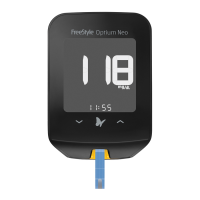
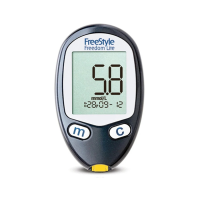


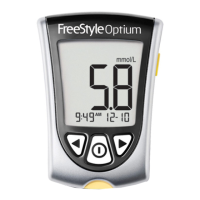

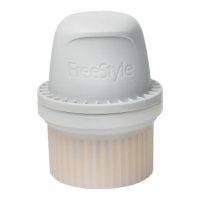
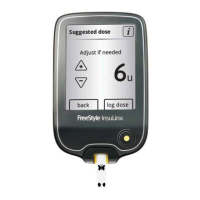
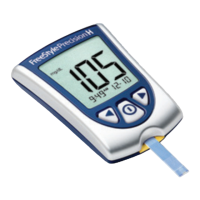
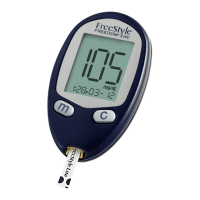

